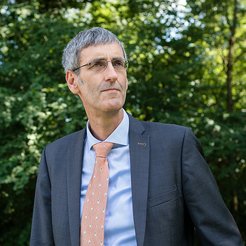Frank Eisenhauer elected to the Paris Academy of Sciences
Great honour for Frank Eisenhauer: the General Assembly of the Académie des sciences, the Paris Academy of Sciences, has elected Frank Eisenhauer, scientist in the infrared group at MPE, as a foreign member. If the corona situation permits at this time, the official admission is to take place on 14 June 2022 in a formal ceremony in Paris.

The astrophysicist Frank Eisenhauer will in future be a member of the Paris Académie des sciences de l'Institut de France. This is one of the oldest academies in the world, which unites outstanding scientists from Germany and abroad. For Eisenhauer, it is another honour after he was awarded the Stern-Gerlach Medal of the German Physical Society last November. In March 2021, Eisenhauer also received the Tycho Brahe Medal, an award, with which the European Astronomical Society (EAS) honours the development or use of European instruments or significant discoveries with such instruments.
The Académie des sciences de l'Institut de France was founded in 1699 by Jean-Baptiste Colbert. His intention was to create an institution devoted exclusively to research. Today, the Academy is divided into two sections: the Department of Mathematics and Physics and the Department of Chemistry, Biology and Medicine. The Academy admits both French and foreign members who have contributed to the progress of science through special achievements. The criteria for this are the originality of the research, the international presence as well as the promoting influence on young scientists.
Eisenhauer works as a scientist at MPE in the Infrared Department, which is headed by Director and Nobel Prize Laureate Reinhard Genzel. It deals with the black hole at the centre of our Milky Way and the evolution of galaxies. To do this, the researchers can use an arsenal of instruments and the world's largest telescopes and space observatories. Two of these groundbreaking projects are led by Frank Eisenhauer: SINFONI and GRAVITY.
SINFONI revolutionised the spectroscopy of stars near the black hole at the Galactic centre and the kinematic studies of galaxies at the peak of galaxy formation a few billion years after the Big Bang. The instrument consists of an imaging spectrometer coupled with adaptive optics. The adaptive optics correct for the blur caused by the Earth's atmosphere, and the imaging spectrometer simultaneously acquires images and spectra for each pixel in a single exposure. The development of SINFONI made this so-called integral field spectroscopy the imaging spectroscopy technique of choice for all large telescopes, including the ESO-ELT, a 40m-class telescope currently under construction.
The next major technological breakthrough came with GRAVITY, which interferometrically combines the light from all four VLT telescopes. This allows astronomers to use the four telescopes together as a virtual 130m telescope – sharp enough to spot a house on the moon, if there were any there. After its first three years of scientific operation, GRAVITY has already delivered many groundbreaking results: By combining GRAVITY astrometry and SINFONI spectroscopy, the team was able to measure the gravitational redshift and relativistic precession in the orbit of the star S2 around the black hole at the Galactic centre. GRAVITY also observed gas vortices orbiting SgrA* at about 30% of the speed of light near its innermost stable orbit. These are very clear indications that SgrA* is indeed a massive black hole. But GRAVITY also looks outside our home galaxy: In quasar 3C273, at a distance of about 1.4 billion light-years, the instrument has directly measured the rotation of the "broad-line region", a group of clouds that rotate around the black hole at the centre of this galaxy. GRAVITY also targets the planets of nearby stars; for example, GRAVITY succeeded in revealing the details of the atmosphere of an exoplanet in the constellation Pegasus. The instrument is currently being further developed into GRAVITY+, which will further expand its functionality and sensitivity. This project will also be led by Dr Eisenhauer.
Frank Eisenhauer studied physics at the Technical University of Munich (TUM) and received his doctorate from Ludwig-Maximilians-Universität Munich in 1998. He is currently a senior scientist at MPE and a private lecturer at TUM.












